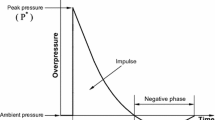Abstract
A typical blast wave as an effective duration of 2–10 ms, and the features of a shock wave in a free field are illustrated in Fig. 1. When explosives or other explosive substances explode, immense energy is generated. When materials are compressed by the impact, compression wave is formed, which quickly spread and propagate in all directions, thereby creating drastic damage to surrounding materials and abruptly elevating pressure to the point of overpressure. A non-linear shock wave includes a discontinuous overpressure front, and pressure, density, and temperature behind the front usually decline according to an index until reaching negative pressure. Thereafter the figures gradually return to baseline, followed by a vacuum phase (cavitation), which then swiftly spread and propagate in all directions, thereby creating drastic damage to surrounding medium. The peak overpressure of a blast wave is related to the quantity of explosives, surrounding environment conditions, and other factors. Structures and solids are subjected to loads that may include many cycles comprised of such periodic overpressures and cavitation. Once a vertical shock wave (particle velocity parallel to wave velocity) hits a solid structure, without a doubt it would create some kind of shear (non-zero part of particle velocity perpendicular to wave velocity). In various isotropic materials, this kind of composite force is easy to dissipate. However, in various anisotropic materials, stress wave would create many qualitatively different transformations, which increase the difficulty of predicting responses in such solids. At the same time, in this kind of material, new mechanisms (dissipation, resonance, etc.) may be introduced to effectively defend against stress waves.
Access this chapter
Tax calculation will be finalised at checkout
Purchases are for personal use only
Similar content being viewed by others
Bibliography
Agrawal V, Holzworth K, Nantasetphong W, et al. Prediction of viscoelastic properties with coarse-grained molecular dynamics and experimental validation for a benchmark polyurea system. J Polym Sci. 2016;54:797–810.
Zhang S, Zhuang Z. Composite materials and viscoelastic mechanics. 2nd ed. Bei**g: China Machine Press; 2011.
Rojek J. Implementation of a molecular dynamics coarse-grained model for studying viscoelastic properties of polyurea. In: Computational mechanics master’s thesis for the joint program of Tsinghua University and four European universities; 2016.
Grujicic M, Bell WC, Pandurangan B, et al. Fluid/structure interaction computational investigation of blast-wave mitigation efficacy of the advanced combat helmet. J Mater Eng Perform. 2011;20:877–93.
Author information
Authors and Affiliations
Corresponding author
Editor information
Editors and Affiliations
Rights and permissions
Copyright information
© 2023 The Author(s), under exclusive license to Springer Nature Singapore Pte Ltd.
About this chapter
Cite this chapter
Zhuo, Z., Liu, Z. (2023). Mechanical Mechanisms and Simulation of Blast Wave Protection. In: Wang, Z., Jiang, J. (eds) Explosive Blast Injuries. Springer, Singapore. https://doi.org/10.1007/978-981-19-2856-7_5
Download citation
DOI: https://doi.org/10.1007/978-981-19-2856-7_5
Published:
Publisher Name: Springer, Singapore
Print ISBN: 978-981-19-2855-0
Online ISBN: 978-981-19-2856-7
eBook Packages: MedicineMedicine (R0)




